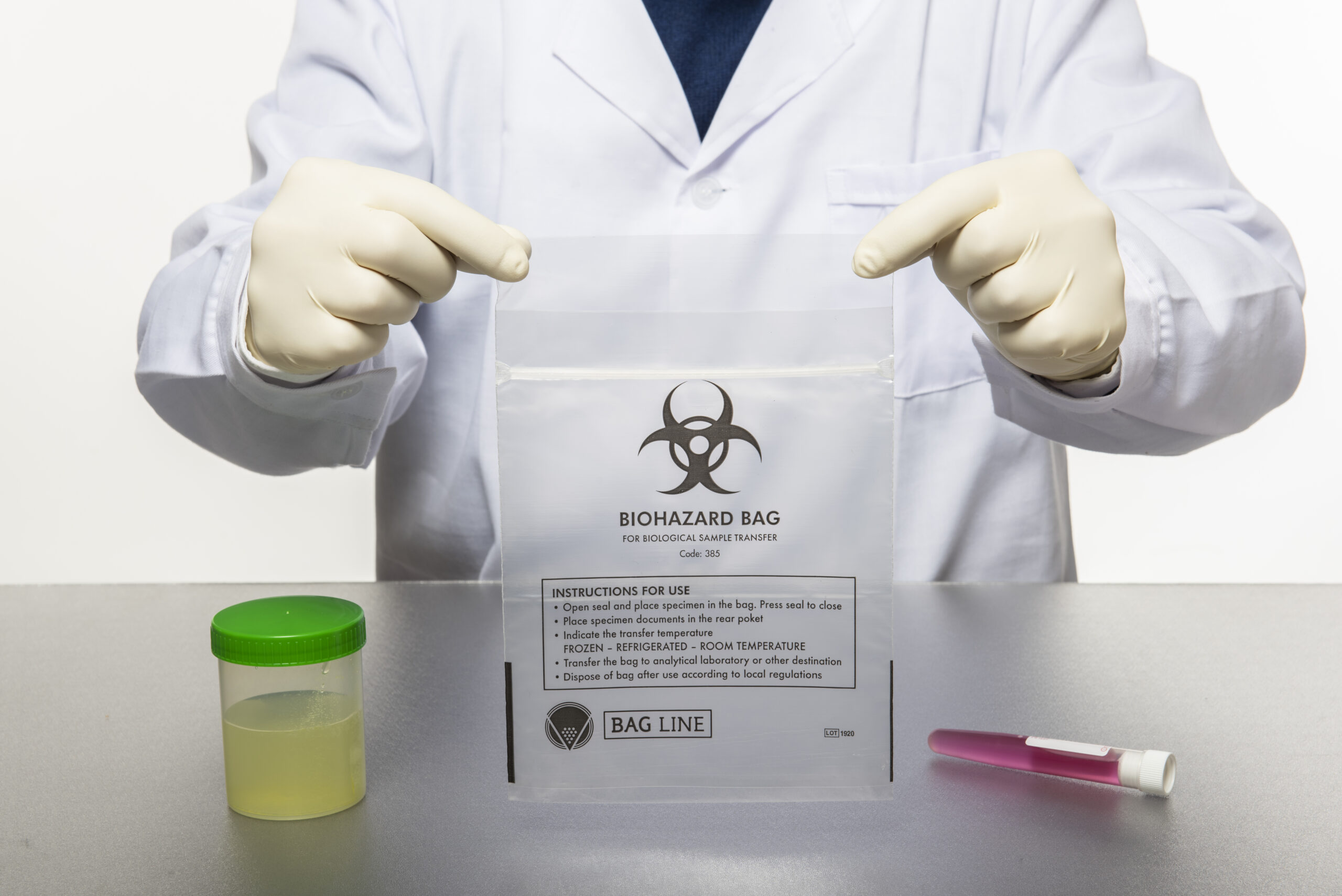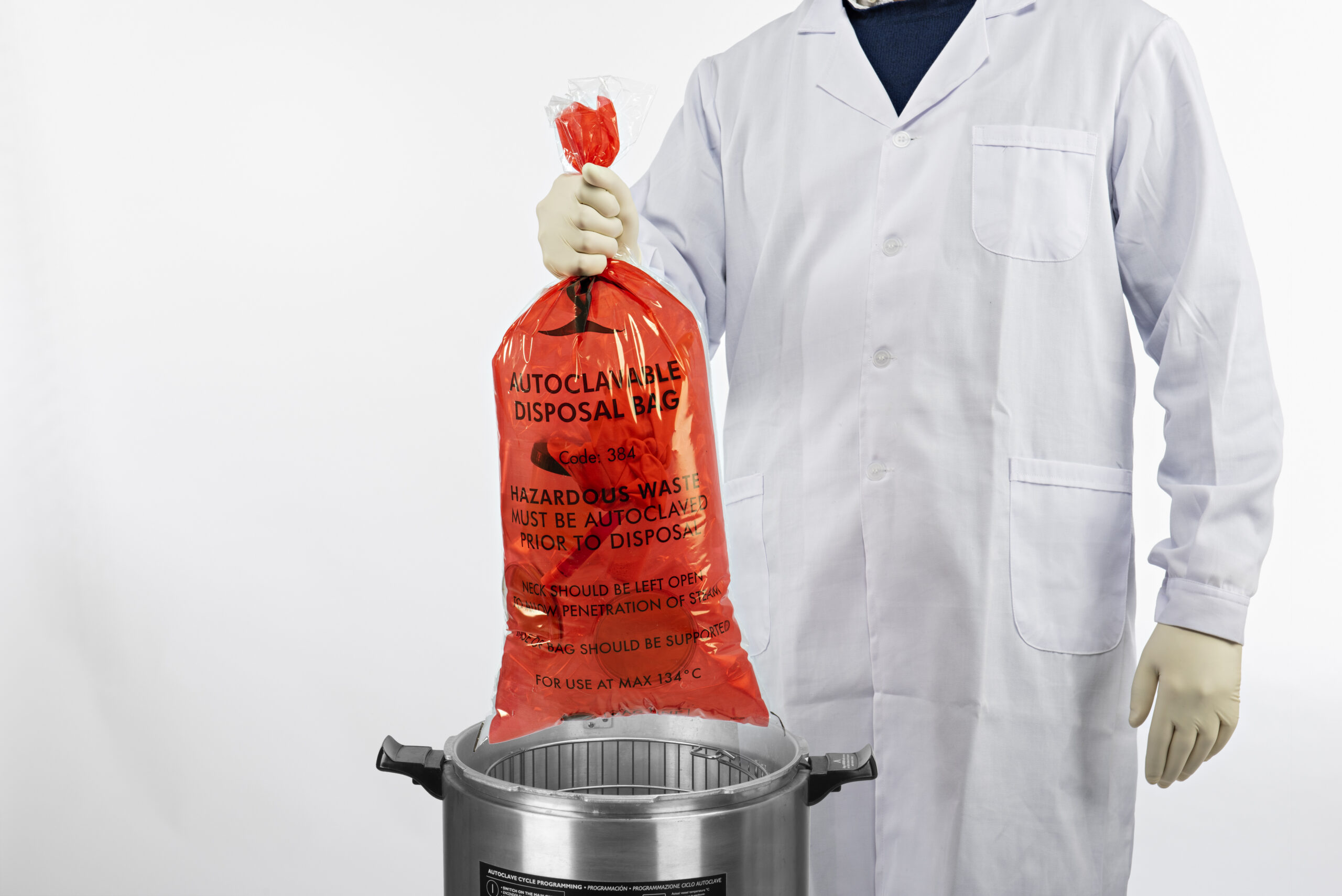QUESTIONS & ANSWERS
–
BIO-SAFETY IN LABORATORY
–
WHICH ARE THE BIO-SAFETY PROCEDURES TO BE APPLIED FOR THE MANAGEMENT OF HIGHLY INFECTIOUS WASTE?
Health care medical specimen (urine and faecis containers, swabs, test tubes, etc,) should be transferred in transit to the analytical laboratory under a controlled safety.
Paper, cell cultures, pipettes, plastics, test tubes, etc. at the end of their use they must be disposed of according to specific logic and directive.
All this for safety reasons, out of respect for the environment, to safeguard colleagues and, last but not least, to avoid penalties for not respecting the current provisions of the law.
This Application Note provides an example of a POS that should be available to all personnel in any analytical laboratory.
–
HOW SHOULD BE PREPARED A STANDARD OPERATIVE PROCEDURE FOR SPECIMEN TRANSFER AND ELIMINATION OR DISPOSAL OF WASTE PRODUCED IN THE ANALYTICAL LABORATORY?
STANDARD OPERATIVE PROCEDURE
OBJECT
Specimen transfer and elimination and / or disposal of waste produced in the analysis laboratory.
PURPOSE
Clarify to the staff the measures to be implemented in order to correctly transfer the specimen and eliminate and / dispose of the waste produced, in accordance with current legislation, current Good Laboratory Practice and Common Sense.
RESPONSIBILITY
Director of the Analysis Laboratory in concert with the Head of Security.
TERMINOLOGY
Autoclave, Bag, Biohazard, Biological risk, Biomedical, Cleanroom, Culture plate, Disinfection, HCV, HCWM, Infectious, Sterilization, Waste, W.H.O.
DOCUMENTATION
W.H.O. – National Health Care Waste Management Plan – Guidance Manual
MATERIAL
|
Transparent BIOHAZARD BAG for biological sample transfer Two separated pockets: one for specimen and one for the documents Instructions for use Open seal and place specimen in the bag. Press seal to close. Place specimen document in the rear pocket Indicate the transfer temperature (Frozen – Refrigerated – Room temperature) Transfer the bag to the analytical laboratory or other destination Dispose of bag after use according to local regulations.
|
|
Yellow Biohazard Pocket Super Bag with antitampering closure for biological samples Two separated pockets: one for specimen and one for the documents Anti-tampering closure Instructions for use Insert specimen in longer pouch Pull off the liner from the top and press it against the dashed band for antitampering closure Place specimen documents in the shorter pouch Indicate the transfer temperature (Frozen – Refrigerated – Room Temperature) Transfer the bag to analytical laboratory or other destination SPECIMEN COLLECTION Tear at score to open Dispose of bag after use according to local regulation.
|
|
RED Steribag – Autoclavable Disposal Bag For inactivation of infected material before destruction Instructions for use The hazardous waste must be autoclaved prior to disposal Neck should be left open to allow penetration of steam Base of bag should be supported Typical sterilization cycle is 121°C / minutes Max Sterilization temperature 134°C.
|
PROCEDURES
W.H.O. – National Health Care Waste Management Plan – Guidance Manual
ANNEXE 3
HCWM PROCEDURES TO BE APPLIED IN MEDICAL LABORATORIES
(181) The management of HCW in medical laboratories remains a sensitive issue since highly infectious waste of category C2 are often generated there. International standard procedures of highly infectious waste management should therefore be respected. They are summarized in the table below. Consequently, each laboratory should be equipped with the adequate material and rigorous protocols set-up to ensure a pre-treatment of the highly infectious waste before it joins the other medical waste for final treatment/disposal.
(182) Highly infectious waste from medical laboratories, such as media or culture plates, should be collected in leak proof yellow bags or containers suitable for autoclaving and properly sealed. Ideally, each laboratory should have an autoclave room dedicated for the specific pre-treatment of this category of waste only. No office waste or other miscellaneous waste should be placed in this room, which shouldn’t be either used for waste storage. Once disinfected, medical laboratory waste should be collected and treated with the infectious HCW of category C1.
(183) If a distinct autoclave isn’t available at the medical laboratory to ensure a thermal treatment, highly infectious waste should be disinfected in a solution of sodium hypochlorite in concentrated form and left overnight. It should then be discarded in a specific yellow bag, properly sealed before joining the hazardous HCW of category C1
(12) According to the Technical Guidelines on Environmentally Sound Management of Biomedical and Health-care waste provided by the Conference of the Parties to the Basel Convention on the Control of Trans-boundary Movements of Hazardous Waste and their Disposal (December 2002), health-care waste are classified as follows: (see figure 1):

Step |
Action |
|
Segregation |
Highly infectious waste should be:
|
|
Pre-treatment |
Highly infectious waste should be immediately pre-treated (i.e. autoclaved or chemically treated) before joining the other medical waste. |
|
Packaging |
Yellow bags should be labelled with the biohazard symbol and clearly marked with the words “highly infectious waste” with a comment on whether it has been pre-treated or not. |
|
Labelling |
Yellow bags should be labelled with the name of the institution and department, type of waste, date, name and signature of person sealing the bag/container. |
|
Storage, transport and treatment |
Disinfected highly infectious waste packaged in yellow bags is no longer regarded as highly infectious and can therefore leave the medical area with other yellow-bagged waste, stored, transported and disposed of |
ANNEXE 4
HCWM PROCEDURES TO BE APPLIED
Procedures for the management of highly infectious waste
(184) During the handling of HCW in medical laboratories, a number of precautions should be taken to avoid cross-contamination, such as:
- The re-useable laboratory items should never be mixed with disposable ones;
- The contaminated items must be autoclaved or alternatively chemically disinfected and should never be discarded with general waste;
- Single-use/disposable laboratory items must be autoclaved and never discarded with general waste;
- All sharps (including broken glass) must be autoclaved and never discarded with general waste. They must be disposed of in approved yellow sharps containers.
IMPROVEMENTS
(188) A survey should be conducted on the current HCWM situation within the hospital in order to identify the necessary improvements. In close cooperation with head nurses from the medical departments, the HCWMO should be responsible in coordinating the survey and analysing the results as well as reviewing and assessing the existing waste management situation. In the same way the mission carried out this analysis at national level, every HCWMO should do it in his/her HCF:
- 10. Compile general information: types of waste generated in the health-care establishment, number of beds, occupancy rates, number of medical departments, etc;
- 11. Conduct a waste generation survey: waste composition, waste quantity, sources of generation and number of beds in use. The survey results should be presented in the form of average daily quantities of waste generated (in kg) in each HCW category from each department;
- 12. Conduct a critical review of existing waste management practices, (i.e. segregation, storage, collection, transport, treatment and disposal);
- 13. Quantify the number of trolleys, containers and other equipment used in waste handling, collection and transportation;
- 14. Identify the costs related to waste management;
- 15. Assess existing safety (e.g. protective clothing) and security measures (e.g. in case of spills and chemicals accidents);
- 16. Evaluate the contingency measures applied in case of a breakdown of HCW treatment units or during close down for planned maintenance (e.g. safe procedures for handling laboratory wastes in case of breakdown of the autoclave);
- 17. Raise awareness amongst health-workers;
- 18. Prepare drawings or sketches of the HCF showing, storage areas for hazardous and other types of waste, on-site treatment facilities, waste collection trolleys routes through the HCF (e.g. routes for transportation of general and hazardous waste outside medical department), areas for washing and disinfecting waste collection trolleys, etc;
- 19. Prepare drawings of each medical department, floor or building showing: location of individual HCW collection points (at least for medical waste, sharps and domestic waste), location of temporary storage areas/containers, routes for internal transport of waste in medical departments (at least for hazardous waste), location of equipment for disinfection;
- 20. Prepare drawings and specifications of: PE waste bags (thickness, width and length), containers (for medical waste and sharps, etc.), trolleys and wheeled containers for internal collection and, transport, protective clothing to be used in the handling of each category of waste (e.g. gloves, masks, plastic aprons, overalls, boots…).
REFERENCE
W.H.O. Waste Guidance on HCWM.
| DOCUMENT APPROVED BY
(Position in the company) |
NAME | SIGNATURE | DATE |
| – | – | – | – |
| – | – | – | – |
| – | – | – | – |
| – | – | – | – |
–



